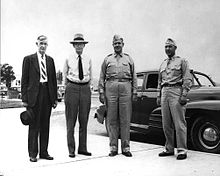Manhattan Project[edit]
Bush played a critical role in persuading the United States government to undertake a crash program to create an atomic bomb.[64] When the NDRC was formed, the Committee on Uranium was placed under it, reporting directly to Bush as the Uranium Committee. Bush reorganized the committee, strengthening its scientific component by adding Tuve, George B. Pegram, Jesse W. Beams, Ross Gunn and Harold Urey.[65] When the OSRD was formed in June 1941, the Uranium Committee was again placed directly under Bush. For security reasons, its name was changed to the Section S-1.[66]

Left to right: Vannevar Bush, James B. Conant, Major General Leslie Groves and Colonel Franklin Matthias at the Hanford Site in July 1945
Bush met with Roosevelt and Vice President Henry A. Wallace on October 9, 1941, to discuss the project. He briefed Roosevelt on Tube Alloys, the British atomic bomb project and its Maud Committee, which had concluded that an atomic bomb was feasible, and on the German nuclear energy project, about which little was known. Roosevelt approved and expedited the atomic program. To control it, he created a Top Policy Group consisting of himself—although he never attended a meeting—Wallace, Bush, Conant, Stimson and the Chief of Staff of the Army, General George Marshall.[67] On Bush’s advice, Roosevelt chose the army to run the project rather than the navy, although the navy had shown far more interest in the field, and was already conducting research into atomic energy for powering ships. Bush’s negative experiences with the Navy had convinced him that it would not listen to his advice, and could not handle large-scale construction projects.[68][69]
In March 1942, Bush sent a report to Roosevelt outlining work by Robert Oppenheimer on the nuclear cross section of uranium-235. Oppenheimer’s calculations, which Bush had George Kistiakowsky check, estimated that the critical mass of a sphere of Uranium-235 was in the range of 2.5 to 5 kilograms, with a destructive power of around 2,000 tons of TNT. Moreover, it appeared that plutonium might be even more fissile.[70] After conferring with Brigadier General Lucius D. Clay about the construction requirements, Bush drew up a submission for $85 million in fiscal year 1943 for four pilot plants, which he forwarded to Roosevelt on June 17, 1942. With the Army on board, Bush moved to streamline oversight of the project by the OSRD, replacing the Section S-1 with a new S-1 Executive Committee.[71]
Bush soon became dissatisfied with the dilatory way the project was run, with its indecisiveness over the selection of sites for the pilot plants. He was particularly disturbed at the allocation of an AA-3 priority, which would delay completion of the pilot plants by three months. Bush complained about these problems to Bundy and Under Secretary of War Robert P. Patterson. Major General Brehon B. Somervell, the commander of the army’s Services of Supply, appointed Brigadier General Leslie R. Groves as project director in September. Within days of taking over, Groves approved the proposed site at Oak Ridge, Tennessee, and obtained a AAA priority. At a meeting in Stimson’s office on September 23 attended by Bundy, Bush, Conant, Groves, Marshall Somervell and Stimson, Bush put forward his proposal for steering the project by a small committee answerable to the Top Policy Group. The meeting agreed with Bush, and created a Military Policy Committee chaired by him, with Somervell’s chief of staff, Brigadier General Wilhelm D. Styer, representing the army, and Rear Admiral William R. Purnell representing the navy.[72]
At the meeting with Roosevelt on October 9, 1941, Bush advocated cooperating with the United Kingdom, and he began corresponding with his British counterpart, Sir John Anderson.[73] But by October 1942, Conant and Bush agreed that a joint project would pose security risks and be more complicated to manage. Roosevelt approved a Military Policy Committee recommendation stating that information given to the British should be limited to technologies that they were actively working on and should not extend to post-war developments.[74] In July 1943, on a visit to London to learn about British progress on antisubmarine technology,[75] Bush, Stimson, and Bundy met with Anderson, Lord Cherwell, and Winston Churchill at 10 Downing Street. At the meeting, Churchill forcefully pressed for a renewal of interchange, while Bush defended current policy. Only when he returned to Washington did he discover that Roosevelt had agreed with the British. The Quebec Agreement merged the two atomic bomb projects, creating the Combined Policy Committee with Stimson, Bush and Conant as United States representatives.[76]
Bush appeared on the cover of Time magazine on April 3, 1944.[77] He toured the Western Front in October 1944, and spoke to ordnance officers, but no senior commander would meet with him. He was able to meet with Samuel Goudsmit and other members of the Alsos Mission, who assured him that there was no danger from the German project; he conveyed this assessment to Lieutenant General Bedell Smith.[78] In May 1945, Bush became part of the Interim Committee formed to advise the new president, Harry S. Truman, on nuclear weapons.[79] It advised that the atomic bomb should be used against an industrial target in Japan as soon as possible and without warning.[80] Bush was present at the Alamogordo Bombing and Gunnery Range on July 16, 1945, for the Trinity nuclear test, the first detonation of an atomic bomb.[81] Afterwards, he took his hat off to Oppenheimer in tribute.[82]
Before the end of the Second World War, Bush and Conant had foreseen and sought to avoid a possible nuclear arms race. Bush proposed international scientific openness and information sharing as a method of self-regulation for the scientific community, to prevent any one political group gaining a scientific advantage. Before nuclear research became public knowledge, Bush used the development of biological weapons as a model for the discussion of similar issues, an “opening wedge”. He was less successful in promoting his ideas in peacetime with President Harry Truman, than he had been under wartime conditions with Roosevelt.[2][83]
In “As We May Think“, an essay published by the Atlantic Monthly in July 1945, Bush wrote: “This has not been a scientist’s war; it has been a war in which all have had a part. The scientists, burying their old professional competition in the demand of a common cause, have shared greatly and learned much. It has been exhilarating to work in effective partnership.”[84]
